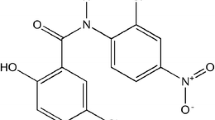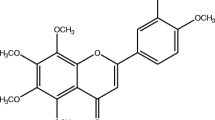Abstract
A novel carbazole compound, named 1-(9-ethyl-9H-carbazol-3-yl)-3-phenylurea (Cpu) was synthesized and its binding properties with protease enzymes (pepsin and trypsin) has been examined by steady-state fluorescence measurements, UV/vis absorption, infrared (FT-IR) and circular dicroism (CD) spectroscopies and also computational methods. The fluorescence experimental results indicated that the quenching mechanism of enzyme by Cpu is static process. The thermodynamic parameters (both negative ΔH/ΔS) and molecular docking results suggested that the binding of Cpu to pepsin/trypsin were driven by hydrogen bonds and van der Waals forces. Based on Förster’s theory, the binding distance (r) between pepsin/trypsin and Cpu was calculated to be 3.072/2.784 nm, which implies that non-radiative energy transfer occurs from enzyme to Cpu. Furthermore, absorption, CD, and FT-IR spectral analysis provided an evidence that the presence of Cpu induced notable changes in the secondary structures and microenvironmental of both pepsin and trypsin, supporting its significant influence on these enzymes.












Similar content being viewed by others
Data Availability
All data generated or analysed during this study are included in this published article.
References
Knölker H-J, Reddy KR (2002) Isolation and synthesis of biologically active carbazole alkaloids. Chem Rev 102:4303–4427. https://doi.org/10.1021/cr020059j
Gluszynska A (2015) Biological potential of carbazole derivatives (Review). Eur J Med Chem 94:405–426. https://doi.org/10.1016/j.ejmech.2015.02.059
Issaa S, Prandinab A, Bedel N, Rongved P, Yous S, Borgne ML, Bouaziz Z (2019) Carbazole scaffolds in cancer therapy: A review from 2012 to 2018. J Enzyme Inhib Med Chem 34:1321–1346. https://doi.org/10.1080/14756366.2019.1640692
Guillonneau C, Pierre A, Charton Y, Guilbaud N, Kraus-Berthier L, Leonce S, Michel A, Bisagni E, Atassi G (1999) Synthesis of 9-o-substituted derivatives of 9-hydroxy-5,6-dimethyl-6H- pyrido[4,3-b] carbazole-1-carboxylic acid (2-(dimethylamino) ethyl) amide and their 10- and 11-methyl analogues with improved antitumor activity. J Med Chem 42:2191–2203. https://doi.org/10.1021/jm981093m
Chylewska A, Dabrowska AM, Ramotowska S, Maciejewska N, Olszewski M, Baginski M, Makowski M (2020) Photosensitive and pH-dependent activity of pyrazine-functionalized carbazole derivative as promising antifungal and imaging agent. Sci Rep 10:11767. https://doi.org/10.1038/s41598-020-68758-w
Addla D, Wen S-Q, GaoW-W MSK, Zhang L, Zhou C-H (2016) Design, synthesis, and biological evaluation of novel carbazole aminothiazoles as potential DNA-targeting antimicrobial agents. MedChemComm 7:1988–1994. https://doi.org/10.1039/C6MD00357E
Tanious FA, Ding D, Patrick DA, Tidwell RR, Wilson WD (1997) A new type of DNA minor-groove complex: Carbazole dication-DNA interactions. Biochemistry 36:15315–15325. https://doi.org/10.1021/bi971599r
Maji B, Kumar K, Kaulage M, Muniyappa K, Bhattacharya S (2014) Design and synthesis of new benzimidazole-carbazole conjugates for the stabilization of human telomeric DNA, telomerase inhibition, and their selective action on cancer cells. J Med Chem 57:6973–6988. https://doi.org/10.1021/jm500427n
Tanious FA, Ding D, Patrick DA, Baily C, Tidwell RR, Wilson WD (2000) Effects of compound structure on carbazole dication-DNA complexes: Tests of the minor-groove complex models. Biochemistry 39:12091–12101. https://doi.org/10.1021/bi001236i
Markad SB, Argade NP (2014) Diversity oriented convergent access for collective total synthesis of bioactive multifunctional carbazole alkaloids: Synthesis of carbazomycin A, carbazomycin B, hyellazole, chlorohyellazole, and clausenaline D. Org Lett 16:5470–5473. https://doi.org/10.1021/ol502721r
Itoigawa M, Kashiwada Y, Ito C, Furukawa H, Tachibana Y, Bastow KF, Lee K-H (2000) Antitumor agents. 203. Carbazole alkaloid Murrayaquinone A and related synthetic carbazolequinones as cytotoxic agents. J Nat Prod 63:893–897. https://doi.org/10.1021/np000020e
Gallou I, Eriksson M, Zeng X, Senanayake C, Farina V (2005) Practical synthesis of unsymmetrical ureas from isopropenyl carbamates. J Org Chem 70:6960–6963. https://doi.org/10.1021/jo0507643
Keating GM, Santoro A (2009) Sorafenib: A review of its use in advanced hepatocellular carcinoma. Drugs 69:223–240. https://doi.org/10.2165/00003495-200969020-00006
Nakamura K, Taguchi E, Miura T, Yamamoto A, Takahashi K, Bichat F, Guilbaud N et al (2006) KRN951, a highly potent inhibitor of vascular endothelial growth factor receptor tyrosine kinases, has antitumor activities and affects functional vascular properties. Cancer Res 66:9134–9142. https://doi.org/10.1158/0008-5472.CAN-05-4290
Li HQ, Lv PC, Yan T, Zhu HL (2009) Urea derivatives as anticancer agents. Anticancer Agents Med Chem 9:471–480. https://doi.org/10.2174/1871520610909040471
Li X, Sun X, Zhao R, Shao D, Bi S (2021) Study on the binding of sulfaclozine sodium monohydrate with bovine and human serum albumins using multi-spectroscopy and molecular docking. J Biomol Struct Dyn 39:4835–4844. https://doi.org/10.1080/07391102.2020.1780945
Moradi SZ, Nowroozi A, Sdarjavadi K, Moradi S, Mansori K, Hosseinzadeh L, Shahlaei M (2018) Direct evidences for the groove binding of clomifene to double stranded DNA. Int J Biol Macromol 114:40–53. https://doi.org/10.1016/j.ijbiomac.2018.03.040
Li X, Liu H, Wu X, Xu R, Mad X, Zhang C, Song Z et al (2021) Exploring the interactions of naringenin and naringin with trypsin and pepsin: Experimental and computational modeling approaches. Spectrochim Acta Part A 258:119859. https://doi.org/10.1016/j.saa.2021.119859
Liu T, Chen X, Xing J, Ge Z (2018) Effects of acetazolamide on the conformations and activities of digestive enzymes: pepsin and trypsin. Med Chem Res 27:1549–1557. https://doi.org/10.1007/s00044-018-2172-2
Lv Y, Liang Q, Li Y, Liu X, Zhang D, Li X (2022) Study of the binding mechanism between hydroxytyrosol and bovine serum albumin using multispectral and molecular docking. FoodHydrocoll 122:107072. https://doi.org/10.1016/j.foodhyd.2021.107072
Gu J, Yang G, Li X, He Q, Huang X, Sun T (2021) Difference in the binding mechanism of distinct antimony forms in bovine serum albumin. Biometals 34:493–510. https://doi.org/10.1007/s10534-021-00291-3
Yessenkyzy A, Saliev T, Zhanaliyeva M, Masoud A-R, Umbayev B, Sergazy S, Krivykh E, Gulyayev A, Nurgozhin T (2020) Polyphenols as caloric-restriction mimetics and autophagy inducers in aging research. Nutrients 12:1344. https://doi.org/10.3390/nu12051344
Das S, Pahari S, Sarmah S, Rohman MA, Paul D, Jana M, Singha Roy A (2019) Lysozyme–luteolin binding: molecular insights into the complexation process and the inhibitory effects of luteolin towards protein modification. Phys Chem Chem Phys 21:12649–12666. https://doi.org/10.1039/C9CP01128E
Das S, Sarmah S, Hazarika RMA, Sarkhel P, Jha AN, Singha Roy A (2020) Targeting the heme protein hemoglobin by (−)-epigallocatechin gallate and the study of polyphenol-protein association using multi-spectroscopic and computational methods. Phys Chem Chem Phys 22:2212–2228. https://doi.org/10.1039/C9CP05301H
Nan G, Wang P, Sun J, Lv J, Ding M, Yang L, Lia Y, Yanga G (2016) Spectroscopy and molecular docking study on the interaction of daidzein and genistein with pepsin. Luminescence 31:1524–1531. https://doi.org/10.1002/bio.3139
Cheng X, Liu B-S, Zhang H-C (2020) Spectroscopic and molecular docking studies of the interaction between meloxicam and pepsin. Spectrosc Lett 53:32–43. Spectroscopic and molecular docking studies of the interaction between meloxicam and pepsin. Spectrosc Lett 53:32–43. https://doi.org/10.1080/00387010.2019.1690522
Suo Z, Ma X, Meng Z, Du Q, Li H (2018) Interaction between trelagliptin and pepsin through spectroscopy methods and molecular dynamics simulation. Spectrosc Lett 51:332–339. https://doi.org/10.1080/00387010.2018.1469154
Ma X, He J, Huang Y, Xiao Y, Wang Q, Li H (2017) Investigation and comparison of the binding between tolvaptan and pepsin and trypsin: Multi spectroscopic approaches and molecular docking. J Mol Recognit 30:2598. https://doi.org/10.1002/jmr.2598
Zhang HM, Zhou QH, Wang YQ (2010) Studies on the interactions of 2, 4-dinitrophenol and 2, 4-dichlorphenol with trypsin. J Fluoresc 20:507–516. https://doi.org/10.1007/s10895-009-0574-8
Shuai L, Chen Z, Fei P, Wang Q, Yang T (2014) Spectroscopic analysis on the interaction of ferulic acid and tetramethylpyrazine with trypsin. Luminescence 29:79–88. https://doi.org/10.1002/bio.2506
Lakowicz JR (2006) Principles of Fluorescence Spectroscopy. Plenum, New York
Bi S, Song D, Tian Y, Zhou X, Liu Z, Zhang H (2005) Molecular spectroscopic study on the interaction of tetracyclines with serum albumins. Spectrochim Acta Part A 61:629–636. https://doi.org/10.1016/j.saa.2004.05.028
Morris GM, Huey R, Lindstrom W, Sanner MF, Belew RK, Goodsell DS, Olson AJ (2009) AutoDock4 and AutoDockTools4: Automated docking with selective receptor flexibility. J Comput Chem 30:2785–2791. https://doi.org/10.1002/jcc.21256
Accelrys Software Inc. Discovery Studio Modeling Environment, Release 3.5 Accelrys Software Inc (2013) San Diego
Frisch MJ, Trucks GW, Schlegel HB, Scuseria GE, Robb MA, Cheeseman JR, Scalmani G et al (2009) Gaussian09, RevisionE.01, Gaussian, Inc.,Wallingford, CT, USA
Gong A, Zhu X, Hu Y, Yu S (2007) A fluorescence spectroscopic study of the interaction between epristeride and bovine serum albumin and its analytical application. Talanta 73:668–673. https://doi.org/10.1016/j.talanta.2007.04.041
Ross PD, Subramanian S (1981) Thermodynamics of protein association reactions: Forces contributing to stability. Biochemistry 20:3096–3102. https://doi.org/10.1021/bi00514a017
Förster T (1948) Intermolecular energy migration and fluorescence. Ann Physics 2:55–75
Lian S, Wang G, Zhou L, Yanga D (2013) Fluorescence spectroscopic analysis on interaction of fleroxacin with pepsin. Luminescence 28:967–972. https://doi.org/10.1002/bio.2469
Guan J, Yan X, Zhao Y, Lu J, Sun Y, Peng X (2019) Investigation of the molecular interactions of triclocarban with human serum albumin using multispectroscopies and molecular modeling. J Biomol Struct Dyn 37:3550–3565. https://doi.org/10.1080/07391102.2018.1520149
Yue Y, Tu Q, Guo Y, Wang Y, Xu Y, Zhang Y, Liu J (2022) Comparison of the interactions of fanetizole with pepsin and trypsin: Spectroscopic and molecular docking approach. J Mol Liq 365:120095. https://doi.org/10.1016/j.molliq.2022.120095
Li Y, Jia B, Wanga H, Li N, Chenb G, Linc Y, Gaob W (2013) The interaction of 2-mercaptobenzimidazole with human serum albumin as determined by spectroscopy, atomic force microscopy and molecular modeling. Colloids Surf B 104:311–317. https://doi.org/10.1016/j.colsurfb.2012.12.023
Zhu S, Bai X, Zhu J, Li W, Wang B (2021) Multi-spectral techniques and molecular docking to investigation of the interaction between ferulic acid and pepsin. Spectrochim Acta Part A 251:119442. https://doi.org/10.1016/j.saa.2021.119442
Pagadala NS, Syed K, Tuszynski J (2017) Software for molecular docking: A review. Biophys Rev 9:91–102. https://doi.org/10.1007/s12551-016-0247-1
Panicker CY, Varghese HT, Manjula PS, Sarojini BK, Narayana B, War JA, Srivastava SK, Alsenoy CV, Al-Saadi AA (2015) FT-IR, HOMO-LUMO, NBO, MEP analysis and molecular docking study of 3-methyl-4-{(E)-[4-(methylsulfanyl)-benzylidene]amino}1H-1,2,4-triazole-5(4H)-thione. Spectrochim Acta Part A 151:198–207. https://doi.org/10.1016/j.saa.2015.06.076
Funding
This work was partially supported by Hacettepe University Scientific Research Fund (BAP Project ID: FBA2017-12854).
Author information
Authors and Affiliations
Contributions
Elmas Gökoğlu: Data curation, Review & Editing. Bensu Doyuran: Investigation, spectroscopic studies, writing-original draft. Gülşah Özen: Investigation, spectroscopic studies. Halil Duyar: Investigation, synthesis and spectral characterizations. Tugba Taskin-Tok: The theoretical calculations. Zeynel Seferoğlu: Data curation.
Corresponding author
Ethics declarations
Ethics Approval
Not applicable.
Consent to Participate
Not applicable.
Consent for Publication
Not applicable.
Competing Interests
The authors declare no competing interests.
Additional information
Publisher's Note
Springer Nature remains neutral with regard to jurisdictional claims in published maps and institutional affiliations.
Supplementary Information
Below is the link to the electronic supplementary material.
Rights and permissions
Springer Nature or its licensor (e.g. a society or other partner) holds exclusive rights to this article under a publishing agreement with the author(s) or other rightsholder(s); author self-archiving of the accepted manuscript version of this article is solely governed by the terms of such publishing agreement and applicable law.
About this article
Cite this article
Gökoğlu, E., Doyuran, B., Özen, G. et al. Evaluation of the Binding Properties of A New Phenylurea Appended Carbazole Compound to Pepsin/Trypsin by Computational and Multi-Spectral Analysis. J Fluoresc (2023). https://doi.org/10.1007/s10895-023-03451-5
Received:
Accepted:
Published:
DOI: https://doi.org/10.1007/s10895-023-03451-5




